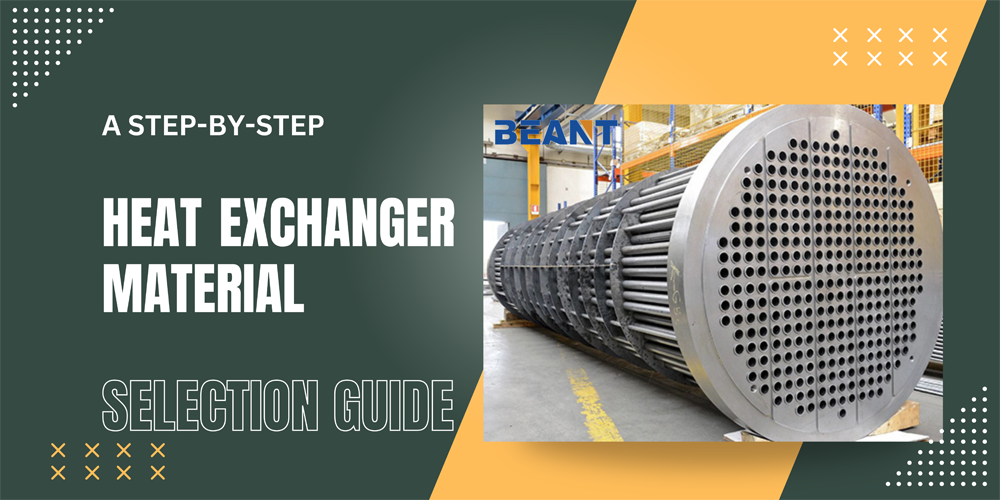
Selecting the appropriate material for a heat exchanger is a critical aspect of design and engineering. The material chosen must withstand the operating conditions while maintaining efficiency and durability. This guide aims to provide a systematic approach to heat exchanger material selection, covering key considerations, criteria, and a step-by-step process.
Before delving into material selection, it's crucial to understand the specific requirements of the heat exchanger. Factors such as temperature range, pressure levels, fluid compatibility, and environmental conditions must be carefully evaluated. Additionally, performance objectives, such as heat transfer efficiency and corrosion resistance, play a significant role in determining material suitability.
Several key criteria influence material selection for heat exchangers:
1.Corrosion Resistance: The material must resist corrosion from the fluid being processed and any environmental factors present.
2.Thermal Conductivity: High thermal conductivity promotes efficient heat transfer, reducing energy consumption and operational costs.
3.Mechanical Properties: The material should possess adequate strength, toughness, and fatigue resistance to withstand operating conditions without failure.
4.Cost: Material cost, including procurement, fabrication, and maintenance, should be considered in relation to the overall project budget.
Each criterion contributes to the overall performance and longevity of the heat exchanger and must be carefully balanced during the selection process.
Several materials are commonly used in heat exchanger construction, each with its own set of properties, advantages, and limitations.
Advantages: Excellent corrosion resistance makes it suitable for harsh chemical environments in industries such as chemical processing and food processing.
Disadvantages: Relatively high cost compared to other materials, which may impact project budgets.
Applications: Widely used in heat exchangers for chemical processing, food and beverage production, pharmaceuticals, and water treatment.
Advantages: High thermal conductivity allows for efficient heat transfer, making it ideal for applications where energy efficiency is a priority, such as HVAC systems and refrigeration.
Disadvantages: Prone to corrosion in certain environments, particularly those with high acidity or alkalinity.
Applications: Commonly used in HVAC systems, refrigeration units, heat pumps, and air conditioning systems.
Advantages: Lightweight and excellent thermal conductivity make it suitable for applications where weight reduction and efficient heat transfer are critical, such as automotive radiators and air conditioning condensers.
Disadvantages: Susceptible to galvanic corrosion when in contact with dissimilar metals in the presence of an electrolyte.
Applications: Used in automotive heat exchangers, air conditioning systems, and aerospace applications where weight savings are essential.
Advantages: High temperature resistance and corrosion resistance make them ideal for demanding applications in petrochemical processing, aerospace, and marine industries.
Disadvantages: Expensive compared to other materials, and certain grades may have limited availability.
Applications: Widely used in petrochemical processing plants, aerospace components, marine equipment, and power generation facilities.
Advantages: Exceptional corrosion resistance, high strength-to-weight ratio, and biocompatibility make it suitable for critical applications in chemical processing, marine environments, and medical devices.
Disadvantages: High cost of raw materials and processing, as well as challenges in fabrication and welding.
Applications: Used in chemical processing equipment, heat exchangers for seawater desalination, aerospace components, and medical implants.
Advantages: Affordable and offers good mechanical properties, making it suitable for a wide range of industrial applications, including power generation, oil refining, and manufacturing.
Disadvantages: Susceptible to corrosion without proper surface treatment and may require additional maintenance to prevent degradation.
Applications: Widely used in power plants for boilers, heat exchangers, pipelines, and storage tanks in oil refineries, and structural components in industrial machinery.
Advantages: Excellent chemical resistance, non-stick properties, and high temperature stability make it suitable for applications involving corrosive fluids and high-purity processes.
Disadvantages: Limited temperature and pressure capabilities compared to metallic materials, and relatively high cost.
Applications: Used in chemical processing equipment, pharmaceutical manufacturing, semiconductor manufacturing, and food processing industries.
The following table provides an overview of these materials:
| Material | Advantages | Disadvantages | Applications |
| Stainless Steel | Excellent corrosion resistance | Relatively high cost | Chemical processing, food industry |
| Copper | High thermal conductivity, good corrosion resistance | Prone to corrosion in certain environments | HVAC systems, refrigeration |
| Aluminum | Lightweight, good thermal conductivity | Susceptible to galvanic corrosion in some situations | Automotive, air conditioning |
| Nickel Alloys | High temperature resistance, corrosion resistance | Expensive, limited availability in certain grades | Petrochemical, aerospace |
| Titanium | Exceptional corrosion resistance, high strength | High cost, challenging to fabricate | Marine, chemical processing |
| Carbon Steel | Affordable, good mechanical properties | Susceptible to corrosion without proper treatment | Power plants, oil refining |
| PTFE | Excellent chemical resistance, non-stick properties | Limited temperature and pressure capabilities | Chemical processing, pharmaceuticals |
Each material offers unique advantages and disadvantages, making careful consideration essential to ensure compatibility with specific application requirements.
1.Define Operating Conditions and Constraints: Identify the temperature, pressure, fluid composition, and other relevant factors.
2.Prioritize Material Selection Criteria: Determine the most critical criteria based on operational needs and project constraints.
3.Evaluate Material Options: Assess available materials against the prioritized criteria, considering performance, cost, and availability.
4.Perform Material Compatibility Testing: Conduct tests, if necessary, to verify material compatibility with the fluid and operating conditions.
5.Finalize Material Selection: Choose the material that best meets the requirements while balancing performance, cost, and other considerations.
In conclusion, selecting the right material for a heat exchanger is a crucial decision that requires careful consideration of various factors. By following a systematic approach and considering key criteria such as corrosion resistance, thermal conductivity, mechanical properties, and cost, engineers can ensure optimal performance and durability. The comprehensive understanding of heat exchanger requirements, coupled with the evaluation of material options, facilitates informed decision-making and enhances project success.
Feel free to leave your message on our board. If you're looking to inquire about prices or place an order, this is the right place! Let us know the details of your needs, and our team will get back to you with a personalized quote as quickly as possible. We're here to ensure your experience is seamless and satisfactory. Share your requirements or ask any questions you might have - we're eager to assist and look forward to doing business with you!
Name:Tim
Phone:+86-15716151880
Email:[email protected]
Company:BEANT
Address:No. 28, Luoshen Road, Luoshe Town, Huishan District, Wuxi City, Jiangsu Province
